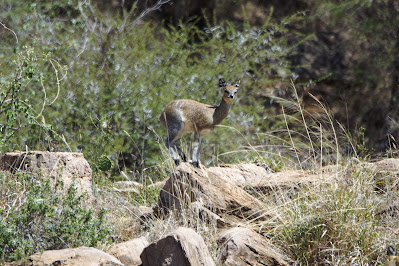Klipspringer (oreotrangus oreotrangus)
The Klipspringer is one of the more elusive antelopes to be found on Loisaba and typically lives on rocky outcrops – they are often to be found on the Sosian Ridge, just above the Ewaso River, or on the Maabati Cliff side of the Kiboko Dam. Closer to headquarters there is a little one-horned Klipspringer and his wife that live on a big lump of rock just beyond the camel boma.
It’s usual to come across them suddenly and then they will often freeze and seem to engage in a game of mutual curiosity.
They are small and stocky, but bigger than the
Dik-Dik, and although in some ways similar, they don’t have the same Womble-like
nose. Their hair is thick and fairly coarse, having hollow fibres. They are
extremely agile and seem to skip across the terrain and up the steep rocks,
often standing at the very top, with their small horns silhouetted against the
sky.
Their colouration varies according to where they live so that they meld into their rocky habitation, but their ears are strikingly striped with black and white. They live in pairs or small family parties, and the ram is territorial – using dung heaps (midden) as a marker. Both sexes mark twigs with a secretion from their pre-orbital glands. Their home range is anything from eight to fifty hectares depending on the available forage and their preferred food is young plants, fruits and flowers although they also eat grass. They are predated upon by eagles, cats, and baboons but have the advantage of their agility. Their biggest danger in Loisaba, as for the Dik-Diks, is the leopard.
The young Klipspringers can be born at any time of year after a gestation period of 210 days. They leave their mothers after about a year. The mating pair tend to be monogamous, forming a life-long partnership.







Comments
Post a Comment